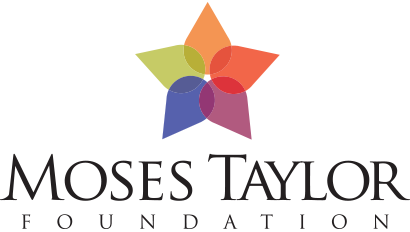Thank You
Thank you to the following organizations for their continued support of our research and this Data Dashboard, which is part of Project STIR (Sparking Transformation using Information & Research).
Population
Decennial census counts indicate that populations in Luzerne and Lackawanna Counties and the state increased compared with previous censuses. From 2010 to 2020, Lackawanna County’s population grew by 0.7 percent, Luzerne County’s population grew by 1.5 percent, and Pennsylvania’s population grew by a slightly faster rate – 2.4 percent. This decade’s growth amounts to about 6,000 more individuals in the two-county region than the previous census. It represents a more rapid growth than the modest population increases seen from 2000 to 2010. Meanwhile, Wayne County saw a population decline that broke with the previous two decades of growth, dropping 3.2 percent (approximately 1,700 people) between 2010 and 2020. Estimates for 2021 showed slight growth in Luzerne and Wayne Counties and a minimal decline in Lackawanna County.
Population Overview
U.S. Census Bureau
Recent Population Trends
U.S. Census Bureau
Migration
During the decade ending in 2020, Lackawanna County saw a negative net migration of 4,755 residents. Luzerne County saw a much smaller net outflow of 73 residents, despite some degree of net in-migration between 2010 and 2012. The sharpest net outflow for both counties took place from 2012 to 2016 but Luzerne County saw some positive inflow years since then. Lackawanna County saw its first positive year in a decade in 2020 and Luzerne County saw its largest inflow among all years analyzed. Aside from 2015 and 2016, Wayne County has seen a consistent inflow of migration with a net gain of 2,754 over the decade.
Lackawanna County Migration
Source: Internal Revenue Service
Luzerne County Migration
Source: Internal Revenue Service
Wayne County Migration
Source: Internal Revenue Service
Birth Rates
Lackawanna County’s birth rate has fluctuated; it consistently fell from 2016 through 2018 until increasing in 2019 only to drop to its lowest point of 18.6 in 2020. In Luzerne County, there were gradual increases in the birth rate, which was 20.7 in 2018 – before dropping in 2019 and 2020 to 19.5. Wayne County’s birth rate varied year to year but ultimately peaked at 18.3 in 2020. The statewide birth rate has declined each year since 2016 and has fallen by 13 percent since 2000.
Birth Rate Per 1,000 Female Residents
Source: Pennsylvania Department of Health
Age Distribution
Looking at the age distribution shows the shift of the baby boomer generation between age groups. In 2000, the majority share of the population was 35 to 44 years old. In 2010, the largest share of the population was 45 to 54 years old, and since 2017 it has been the 55 to 64 demographic. This is true of all three counties and statewide, as the baby boomers comprise a significant demographic group.
Although this group was the largest, 2021 estimates showed relative parity between several age groups. In Luzerne and Lackawanna Counties, for instance, age groups of 25 to 34, 35 to 44, and 45 to 54 ranged from 12 percent to 12.7 percent and the 55 to 64 age group comprised around 14 percent of the population. Statewide, it was even closer with people aged 55 to 64 again comprising 14 percent of the population, people aged 25 to 34 comprising 13.1 percent of the population, and the 45 to 54 and 35 to 44 age groups comprising about 12 percent and 12.4 percent respectively.
Meanwhile, Wayne County has a notably older population distribution than the other counties. Here the demographic of people aged 55 to 64 years is 16.6 percent of the population, compared to a range of 11.4 percent to 12.7 percent for the three younger age groups (25-34, 35-44, and 45-54). In Wayne County, the second largest demographic is the 65 to 74 cohort. The combined demographic of people aged 55 to 74 years makes up over 31 percent of the population in Wayne County, whereas it comprises just over 25 percent of the other geographies’ populations.
Across all geographies, the share of population aged 60 or older has trended upward, especially when compared to the year 2000. This age group accounts for about 27 percent of the populations in Lackawanna and Luzerne Counties and 26 percent statewide. By comparison, the group represented about 24 percent of the regional population in 2000, and less than 20 percent statewide. In 2000, Wayne County had a smaller over-60 population, at under 23 percent. It now has a significantly larger over-60 population, at 33 percent.
Age Distribution: Lackawanna County
U.S. Census Bureau July Population Estimates, 2000 & 2010 Census
Age Distribution: Luzerne County
U.S. Census Bureau July Population Estimates, 2000 & 2010 Census
Age Distribution: Wayne County
U.S. Census Bureau July Population Estimates, 2000 & 2010 Census
Age Distribution: Pennsylvania
U.S. Census Bureau July Population Estimates, 2000 & 2010 Census
Racial & Ethnic Diversity
Ethnic diversity has increased in the three counties as well as the Commonwealth of Pennsylvania. In all geographic areas, the percentages of non-white residents have grown considerably. Between the 2010 and 2020 censuses, the shares of residents identifying as white non-Hispanic fell from 90 percent to 81 percent in Lackawanna County, from 88 percent to 77 percent in Luzerne County, and from 92 percent to 88 percent in Wayne County.
As of 2021, the percentage of Asian American residents in Lackawanna County has more than quadrupled since 2000. Luzerne and Wayne Counties saw their shares of Asian American residents double. The proportion of African American residents in Lackawanna County has grown from 1.2 percent in 2000 to 3.5 percent in 2021. African Americans comprised 4.6 percent of the Luzerne County population in 2021 – up from 1.6 percent in 2000. Wayne County’s proportion of African American residents doubled between 2000 and 2021, from 1.5 percent to more than three percent. These counties have also experienced large increases in their percentages of multiracial residents compared with 2000 and 2010.
The size of the Hispanic/Latino communities in Lackawanna and Luzerne Counties and Pennsylvania have also increased significantly since 2000. In 2000, Hispanic residents accounted for 1.4 percent of Lackawanna County’s population. By the 2020 Census, that share reached 8.5 percent and continued to grow in 2021. Luzerne County’s Hispanic/Latino population accounted for 1.2 percent of residents in 2000, 14.4 percent in 2020, and 16 percent in 2021. The change is present but not as pronounced in Wayne County, with the Hispanic population growing from 1.7 percent in 2000 to 4.6 percent in 2020. This trend began in the first decade of the new millennium, and the rate of growth of the Hispanic population in the region has not appeared to slow substantially from 2010 to 2021. The region’s Hispanic and Latino population growth has been faster than the statewide growth. As of the most recent census, Lackawanna and Luzerne Counties had larger shares of Hispanic residents than Pennsylvania as a whole. The population comes from a number of Latin and South American countries and the Caribbean.
Race by Lackawanna County
Source: U.S. Census Bureau Decennial Census (2000-2020), 2021 Census Bureau Population Estimates
Race by Luzerne County
Source: U.S. Census Bureau Decennial Census (2000-2020), 2021 Census Bureau Population Estimates
Race by Wayne County
Source: U.S. Census Bureau Decennial Census (2000-2020), 2021 Census Bureau Population Estimates
Race by Pennsylvania
Source: U.S. Census Bureau Decennial Census (2000-2020), 2021 Census Bureau Population Estimates
Household Size
The average household size has fluctuated for Lackawanna and Luzerne Counties. It has decreased every year since 2015 in Lackawanna County and since 2016 in Luzerne County before increasing in 2020 and 2021. The state’s average household size meanwhile has continued a slight declining trend. For Lackawanna and Luzerne Counties, the household size remains below the statewide average of 2.4. Wayne County’s average household size has typically hovered above the statewide average but has fallen closer with its recent decline, from a peak of 2.54 in 2018 to 2.45 currently.
Household Size
Source: U.S. Census Bureau American Community Survey
Single Parent Families
The shares single parent households with children under age 18 decreased in all three geographies as of 2019. However, this is due to a data classification change that now excludes unmarried couples with children from this category (for example, a mother or father who lives with their own children and an unmarried partner). The updated estimates provide a more accurate view of single parents raising children without another adult in the household. Nonetheless, in most cases the decline continued. In all three counties, the total percentages of single parent households (both male-headed and female-headed) were lower than the statewide total of 5.6 percent.
Across all geographies, at least 70 percent of single parent households are headed by women, and Lackawanna County has a higher share of female-headed single parent households than Pennsylvania as a whole.
Female Single Parent Households with Children Under 18
Source: U.S. Census Bureau 2010 & 2020 Decennial Census, American Community Survey 1-year estimates (Lackawanna, Luzerne, PA), 5-year estimates (Wayne)
Male Single Parent Households with Children Under 18
Source: U.S. Census Bureau 2010 & 2020 Decennial Census, American Community Survey 1-year estimates (Lackawanna, Luzerne, PA), 5-year estimates (Wayne)
Grandparents Raising Grandchildren
While data for Lackawanna and Luzerne Counties are difficult to analyze (due to many years of insufficient sample sizes for Lackawanna County), the number of grandparents raising grandchildren in Pennsylvania has fluctuated significantly over the period examined. Statewide, the number of grandparents raising grandchildren fell from 2013 to 2017, declining by over 18 percent in that period, but saw two straight years of increases in 2018 and 2019.
Luzerne County saw fluctuation in the number of grandparents raising grandchildren, averaging 2,458 over the last decade. The most recent two years represent the highest and third highest estimates of the ten years analyzed. Data for Lackawanna County is limited, but from 2016 to 2018, the estimated number of grandparents raising grandchildren averaged 1,312.
Grandparents Raising Grandchildren
Source: U.S. Census Bureau American Community Survey
| 2012 | 2013 | 2014 | 2015 | 2016 | 2017 | 2018 | 2019 | 2020 | 2021 | |
|---|---|---|---|---|---|---|---|---|---|---|
| Lackawanna | ND | ND | ND | ND | 1,771 | 959 | 1,207 | ND | ND | ND |
| Luzerne | 2,406 | 2,183 | 2,398 | 2,311 | 2,280 | 2,117 | 3,204 | 2,572 | ND | 2397 |
| Wayne | 312 | 329 | 388 | 358 | 434 | 431 | 418 | 394 | ND | 365 |
| Pennsylvania | 91,564 | 92,964 | 91,531 | 88,495 | 81,884 | 76,005 | 81,392 | 82,556 | ND | 69,758 |
Ratio of Children to Seniors
The ratio of children to seniors is one measure of the population dynamics of a region. A ratio of children to seniors below 1.0 suggests that the replacement rate to maintain steady population is not being met (before accounting for the effects of migration). However, a falling ratio can also indicate that as adults live longer into advanced age, seniors simply represent a larger share of the population compared to other age cohorts. The ratio of children to seniors has shown a downward trend from 2010 to 2019 in all analyzed areas but Luzerne County, which saw an increase from 2018 to 2019. By 2021, Luzerne and Lackawanna Counties saw modest increases while Wayne County saw a continued decline. The statewide ratio has declined since 2010.
Lackawanna Ratio of Children to Seniors
U.S. Census Bureau July Population Estimates, 2000 & 2010 Census
Luzerne Ratio of Children to Seniors
U.S. Census Bureau July Population Estimates, 2000 & 2010 Census
Wayne Ratio of Children to Seniors
U.S. Census Bureau July Population Estimates, 2000 & 2010 Census
Pennsylvania Ratio of Children to Seniors
U.S. Census Bureau July Population Estimates, 2000 & 2010 Census
Older Adults Living Alone
The number of older adults aged 65 years or older living alone fluctuated in the periods examined. Lackawanna County saw two straight years of decline after the estimate spiked in 2017 and rose again to a new high in 2021. Luzerne County saw the second straight year of moderate growth as of 2019 only to decline in 2021. Statewide and in Wayne County, the number of seniors living alone has been steadily growing. In the three counties combined, there have been over 34,000 seniors living alone in each of the past four years.
Seniors Living Alone
Source: U.S. Census Bureau 2010 & 2020 Decennial Census, American Community Survey 1-year estimates (Lackawanna, Luzerne, PA), 5-year estimates (Wayne)
| 2000 | 2017 | 2018 | 2019 | 2021 | |
|---|---|---|---|---|---|
| Lackawanna | 13,529 | 13,620 | 12,504 | 11,953 | 14,639 |
| Luzerne | 20,846 | 18,605 | 19,130 | 19,260 | 18,938 |
| Wayne | 2,233 | 2,748 | 2,757 | 2,804 | 2,968 |
| Pennsylvania | 555,374 | 642,359 | 650,681 | 660,578 | 683,353 |








 Sarah, a former Institute intern, joined The Institute in April 2021 as a Research Assistant. She started her new role as a Research Analyst in January 2024.
Sarah, a former Institute intern, joined The Institute in April 2021 as a Research Assistant. She started her new role as a Research Analyst in January 2024. 

 Jill Avery-Stoss joined The Institute in June 2018 to fill the newly-created role of Research, Data, Intern & Administrative Coordinator. She assists with the collection and management of data for purposes of ethical and efficient analysis. She visits partner campuses to market The Institute’s internship opportunities, and participates in event-planning logistical activities as well. In 2021, Jill was promoted to Director of Operations to reflect the diversity in her job description and the additional marketing and communication functions she successfully mastered in 2020. In 2022, Jill was named Chief Operating Officer after expanding into both research and administrative management functions. Jill is taking on project management, fundraising, and other executive leadership functions of the organization.
Jill Avery-Stoss joined The Institute in June 2018 to fill the newly-created role of Research, Data, Intern & Administrative Coordinator. She assists with the collection and management of data for purposes of ethical and efficient analysis. She visits partner campuses to market The Institute’s internship opportunities, and participates in event-planning logistical activities as well. In 2021, Jill was promoted to Director of Operations to reflect the diversity in her job description and the additional marketing and communication functions she successfully mastered in 2020. In 2022, Jill was named Chief Operating Officer after expanding into both research and administrative management functions. Jill is taking on project management, fundraising, and other executive leadership functions of the organization. Ooms is responsible for all facets of research, organizational strategy, and management. Ooms is an active principal investigator in all Institute research. Ooms has been nationally recognized as a leader in regional economic development. She turned that skill into a research institute to help other regions develop and prosper. Her strategic skills have allowed The Institute to expand its services to the private and non-profit sectors for research and analysis in community health needs assessments, strategic planning, market and feasibility studies, and economic impact analysis.
Ooms is responsible for all facets of research, organizational strategy, and management. Ooms is an active principal investigator in all Institute research. Ooms has been nationally recognized as a leader in regional economic development. She turned that skill into a research institute to help other regions develop and prosper. Her strategic skills have allowed The Institute to expand its services to the private and non-profit sectors for research and analysis in community health needs assessments, strategic planning, market and feasibility studies, and economic impact analysis.